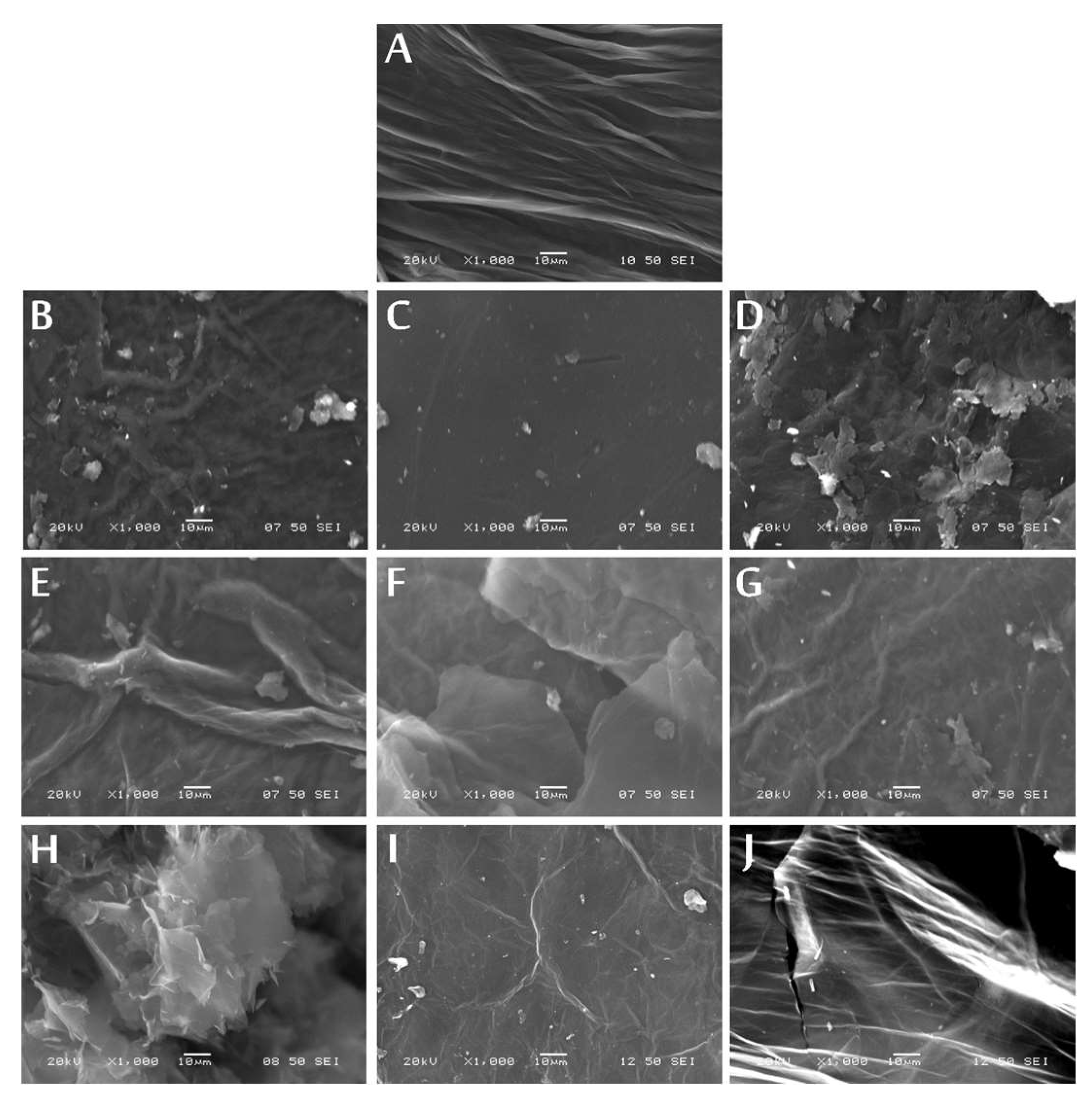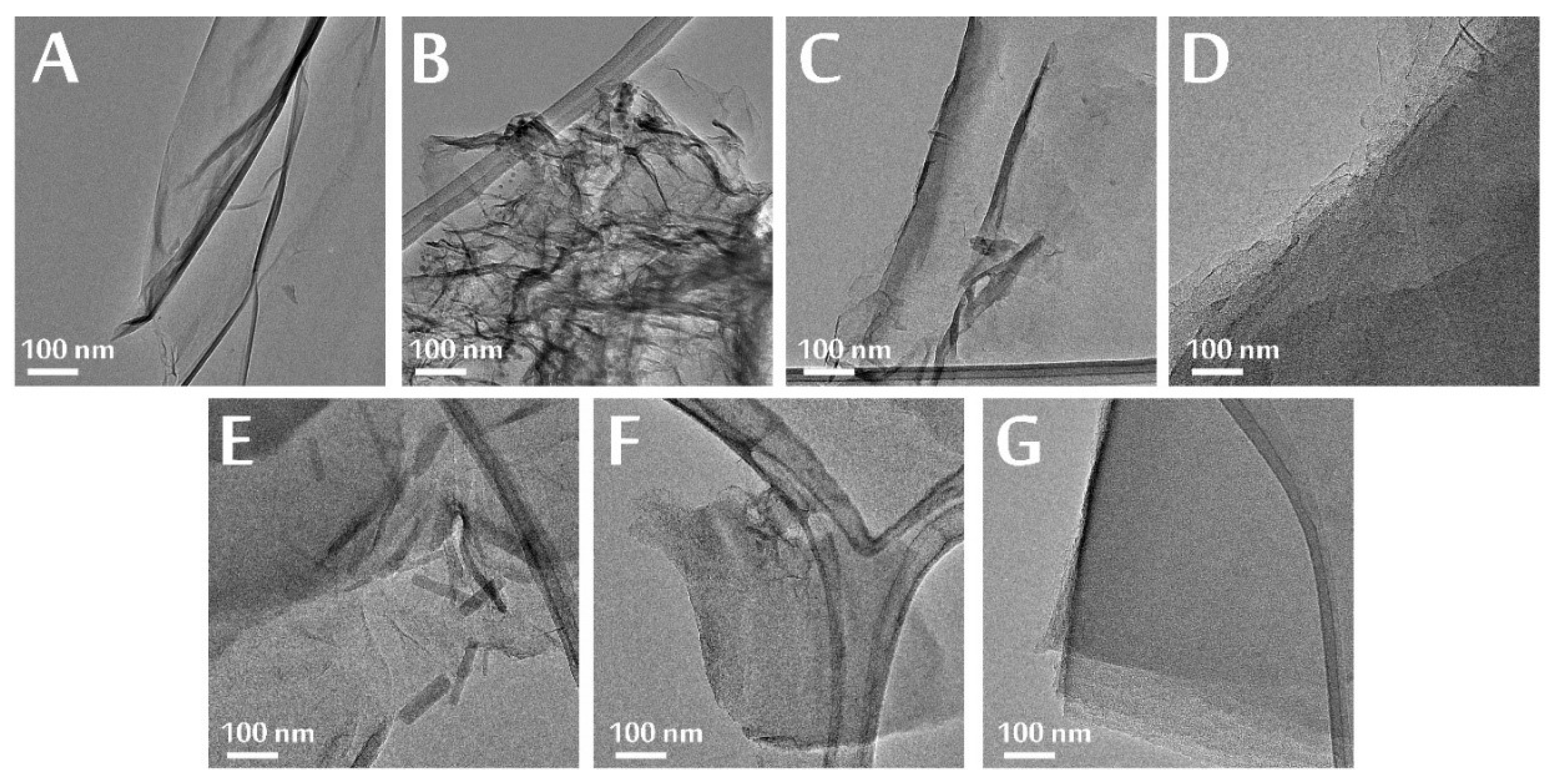Electric and Photocatalytic Properties of Graphene Oxide Depending on the Degree of Its Reduction
Abstract
1. Introduction
2. Materials and Methods
2.1. Preparation of the Graphene Oxide
2.2. Reduction of the Graphene Oxide
- 2.5 mg GO, 10 °C min−1 to 900 °C, (samples: GO-air 900°C, GO-N2 900°C, GO-H2 900°C);
- 8 mg GO, 10 °C min−1 to 200 °C, then 30 min isotherm section, (samples: GO-air 200°C, GO-N2 200°C, GO-H2 200°C);
- 8 mg GO, 10 °C min−1 to 200 °C, then 5 °C min−1 to 300 °C, (samples: GO-air 300°C, GO-N2 300°C, GO-H2 300°C).
2.3. Characterization Methods
3. Results and Discussion
3.1. Characterization
3.2. Application Studies
4. Conclusions
Supplementary Materials
Author Contributions
Funding
Acknowledgments
Conflicts of Interest
References
- Justh, N.; Berke, B.; László, K.; Szilágyi, I.M. Thermal analysis of the improved Hummers’ synthesis of graphene oxide. J. Therm. Anal. Calorim. 2018, 131, 2267–2272. [Google Scholar] [CrossRef]
- Park, S.; Ruoff, R.S. Chemical methods for the production of graphenes. Nat. Nanotechnol. 2009, 4, 217–224. [Google Scholar] [CrossRef]
- Geim, A.K. Graphene: Status and Prospects. Science 2009, 324, 1530–1534. [Google Scholar] [CrossRef] [PubMed]
- Zhang, J.; Yang, H.; Shen, G.; Cheng, P.; Zhang, J.; Guo, S. Reduction of graphene oxide via L-ascorbic acid. Chem. Commun. 2010, 46, 1112–1114. [Google Scholar] [CrossRef] [PubMed]
- Mathkar, A.; Tozier, D.; Cox, P.; Ong, P.; Galande, C.; Balakrishnan, K.; Leela Mohana Reddy, A.; Ajayan, P.M. Controlled, Stepwise Reduction and Band Gap Manipulation of Graphene Oxide. J. Phys. Chem. Lett. 2012, 3, 986–991. [Google Scholar] [CrossRef] [PubMed]
- Wang, Z.; Xu, D.; Huang, Y.; Wu, Z.; Wang, L.-M.; Zhang, X.-B. Facile, mild and fast thermal-decomposition reduction of graphene oxide in air and its application in high-performance lithium batteries. Chem. Commun. 2012, 48, 976–978. [Google Scholar] [CrossRef] [PubMed]
- Ong, W.-J.; Tan, L.-L.; Chai, S.-P.; Yong, S.-T.; Mohamed, A.R. Surface charge modification via protonation of graphitic carbon nitride (g-C3N4) for electrostatic self-assembly construction of 2D/2D reduced graphene oxide (rGO)/g-C3N4 nanostructures toward enhanced photocatalytic reduction of carbon dioxide to methane. Nano Energy 2015, 13, 757–770. [Google Scholar] [CrossRef]
- Abdolhosseinzadeh, S.; Asgharzadeh, H.; Seop Kim, H. Fast and fully-scalable synthesis of reduced graphene oxide. Sci. Rep. 2015, 5, 10160. [Google Scholar] [CrossRef]
- Kong, W.; Kum, H.; Bae, S.-H.; Shim, J.; Kim, H.; Kong, L.; Meng, Y.; Wang, K.; Kim, C.; Kim, J. Path towards graphene commercialization from lab to market. Nat. Nanotechnol. 2019, 14, 927–938. [Google Scholar] [CrossRef]
- Fernández-Merino, M.J.; Guardia, L.; Paredes, J.I.; Villar-Rodil, S.; Solís-Fernández, P.; Martínez-Alonso, A.; Tascón, J.M.D. Vitamin C Is an Ideal Substitute for Hydrazine in the Reduction of Graphene Oxide Suspensions. J. Phys. Chem. C 2010, 114, 6426–6432. [Google Scholar] [CrossRef]
- Guerrero-Contreras, J.; Caballero-Briones, F. Graphene oxide powders with different oxidation degree, prepared by synthesis variations of the Hummers method. Mater. Chem. Phys. 2015, 153, 209–220. [Google Scholar] [CrossRef]
- Velasco-Soto, M.A.; Pérez-García, S.A.; Alvarez-Quintana, J.; Cao, Y.; Nyborg, L.; Licea-Jiménez, L. Selective band gap manipulation of graphene oxide by its reduction with mild reagents. Carbon 2015, 93, 967–973. [Google Scholar] [CrossRef]
- Hunt, A.; Kurmaev, E.Z.; Moewes, A. Band gap engineering of graphene oxide by chemical modification. Carbon 2014, 75, 366–371. [Google Scholar] [CrossRef]
- Tu, N.D.K.; Choi, J.; Park, C.R.; Kim, H. Remarkable Conversion Between n- and p-Type Reduced Graphene Oxide on Varying the Thermal Annealing Temperature. Chem. Mater. 2015, 27, 7362–7369. [Google Scholar] [CrossRef]
- Chen, L.; Tang, Y.; Wang, K.; Liu, C.; Luo, S. Direct electrodeposition of reduced graphene oxide on glassy carbon electrode and its electrochemical application. Electrochem. Commun. 2011, 13, 133–137. [Google Scholar] [CrossRef]
- Zhao, B.; Liu, P.; Jiang, Y.; Pan, D.; Tao, H.; Song, J.; Fang, T.; Xu, W. Supercapacitor performances of thermally reduced graphene oxide. J. Power Sources 2012, 198, 423–427. [Google Scholar] [CrossRef]
- El-Kady, M.F.; Shao, Y.; Kaner, R.B. Graphene for batteries, supercapacitors and beyond. Nat. Rev. Mater. 2016, 1, 16033. [Google Scholar] [CrossRef]
- Wu, H.; Zhang, Y.; Cheng, L.; Zheng, L.; Li, Y.; Yuan, W.; Yuan, X. Graphene based architectures for electrochemical capacitors. Energy Storage Mater. 2016, 5, 8–32. [Google Scholar] [CrossRef]
- Xiang, Q.; Yu, J.; Jaroniec, M. Graphene-based semiconductor photocatalysts. Chem. Soc. Rev. 2012, 41, 782–796. [Google Scholar] [CrossRef]
- Tong, H.; Ouyang, S.; Bi, Y.; Umezawa, N.; Oshikiri, M.; Ye, J. Nano-photocatalytic Materials: Possibilities and Challenges. Adv. Mater. 2012, 24, 229–251. [Google Scholar] [CrossRef]
- Leary, R.; Westwood, A. Carbonaceous nanomaterials for the enhancement of TiO2 photocatalysis. Carbon 2011, 49, 741–772. [Google Scholar] [CrossRef]
- Khalid, N.R.; Majid, A.; Tahir, M.B.; Niaz, N.A.; Khalid, S. Carbonaceous-TiO2 nanomaterials for photocatalytic degradation of pollutants: A review. Ceram. Int. 2017, 43, 14552–14571. [Google Scholar] [CrossRef]
- Kavitha, T.; Gopalan, A.I.; Lee, K.-P.; Park, S.-Y. Glucose sensing, photocatalytic and antibacterial properties of graphene–ZnO nanoparticle hybrids. Carbon 2012, 50, 2994–3000. [Google Scholar] [CrossRef]
- Wang, A.; Li, X.; Zhao, Y.; Wu, W.; Chen, J.; Meng, H. Preparation and characterizations of Cu2O/reduced graphene oxide nanocomposites with high photo-catalytic performances. Powder Technol. 2014, 261, 42–48. [Google Scholar] [CrossRef]
- Sharma, M.; Behl, K.; Nigam, S.; Joshi, M. TiO2-GO nanocomposite for photocatalysis and environmental applications: A green synthesis approach. Vacuum 2018, 156, 434–439. [Google Scholar] [CrossRef]
- Li, X.; Yu, J.; Wageh, S.; Al-Ghamdi, A.A.; Xie, J. Graphene in Photocatalysis: A Review. Small 2016, 12, 6640–6696. [Google Scholar] [CrossRef] [PubMed]
- Justh, N.; Berke, B.; László, K.; Bakos, L.P.; Szabó, A.; Hernádi, K.; Szilágyi, I.M. Preparation of graphene oxide/semiconductor oxide composites by using atomic layer deposition. Appl. Surf. Sci. 2018, 453, 245–251. [Google Scholar] [CrossRef]
- Yeh, T.F.; Syu, J.M.; Cheng, C.; Chang, T.H.; Teng, H. Graphite oxide as a photocatalyst for hydrogen production from water. Adv. Funct. Mater. 2010, 20, 2255–2262. [Google Scholar] [CrossRef]
- Velasco, L.F.; Carmona, R.J.; Matos, J.; Ania, C.O. Performance of activated carbons in consecutive phenol photooxidation cycles. Carbon 2014, 73, 206–215. [Google Scholar] [CrossRef]
- Marcano, D.C.; Kosynkin, D.V.; Berlin, J.M.; Sinitskii, A.; Sun, Z.; Slesarev, A.; Alemany, L.B.; Lu, W.; Tour, J.M. Improved Synthesis of Graphene Oxide. ACS Nano 2010, 4, 4806–4814. [Google Scholar] [CrossRef]
- Eigler, S.; Dotzer, C.; Hof, F.; Bauer, W.; Hirsch, A. Sulfur Species in Graphene Oxide. Chem. A Eur. J. 2013, 19, 9490–9496. [Google Scholar] [CrossRef] [PubMed]
- Whitener, K.E. Review Article: Hydrogenated graphene: A user’s guide. J. Vac. Sci. Technol. A 2018, 36, 05G401. [Google Scholar] [CrossRef]
- Qiu, Y.; Guo, F.; Hurt, R.; Külaots, I. Explosive thermal reduction of graphene oxide-based materials: Mechanism and safety implications. Carbon 2014, 72, 215–223. [Google Scholar] [CrossRef] [PubMed]
- Eigler, S. Controlled Chemistry Approach to the Oxo-Functionalization of Graphene. Chem. A Eur. J. 2016, 22, 7012–7027. [Google Scholar] [CrossRef] [PubMed]
- Hun, S. Thermal Reduction of Graphene Oxide. In Physics and Applications of Graphene-Experiments; InTech: Rijeka, Croatia, 2011. [Google Scholar]
- Wang, K.; Pang, J.; Li, L.; Zhou, S.; Li, Y.; Zhang, T. Synthesis of hydrophobic carbon nanotubes/reduced graphene oxide composite films by flash light irradiation. Front. Chem. Sci. Eng. 2018, 12, 376–382. [Google Scholar] [CrossRef]
- Tang, C.-H.; Chen, K.-Y.; Chen, C.-Y. Solution-processed ZnO/Si based heterostructures with enhanced photocatalytic performance. New J. Chem. 2018, 42, 13797–13802. [Google Scholar] [CrossRef]
- Tang, C.-H.; Hsiao, P.-H.; Chen, C.-Y. Efficient Photocatalysts Made by Uniform Decoration of Cu2O Nanoparticles on Si Nanowire Arrays with Low Visible Reflectivity. Nanoscale Res. Lett. 2018, 13, 312. [Google Scholar] [CrossRef]
- Hsiao, P.-H.; Li, T.-C.; Chen, C.-Y. ZnO/Cu2O/Si Nanowire Arrays as Ternary Heterostructure-Based Photocatalysts with Enhanced Photodegradation Performances. Nanoscale Res. Lett. 2019, 14, 244. [Google Scholar] [CrossRef]










| Sample | Deconvolution of C1s Peak/at. % | Elemental Composition/at. % | |||||||
|---|---|---|---|---|---|---|---|---|---|
| sp2 Graphitic Carbon284.4 eV | sp3 Carbon 285.4 eV | C-O 286.8 eV | C=O 288.4 eV | O-C=O /Loss Feature 290.4 eV | C1s | S2p | O1s | N1s | |
| GO | 5.38 | 44.3 | 31.8 | 13.2 | 5.35 | 67.2 | 0.3 | 32.5 | |
| GO AA | 7.73 | 73.2 | 7.45 | 3.63 | 8.02 | 67.6 | 32.4 | ||
| GO-air 300 °C | 46.3 | 32.9 | 3.41 | 8.28 | 9.09 | 80.2 | 0.15 | 19.6 | |
| GO-N2 300 °C | 48.8 | 26.9 | 7.86 | 5.21 | 11.2 | 78.6 | 0.34 | 20.3 | 0.74 |
| GO-H2 300 °C | 39.5 | 39.1 | 6.85 | 5.73 | 8.80 | 82.6 | 0.67 | 16.8 | |
| Sample | d001/nm | d002/nm | D002/nm | N/- |
|---|---|---|---|---|
| GO | 0.81 | |||
| GO AA | 0.63 | 0.39 | 0.62 | 1.6 |
| GO-air 200 °C | 0.47 | 0.37 | 2.25 | 6.0 |
| GO-N2 200 °C | 0.47 | 0.37 | 2.13 | 5.7 |
| GO-H2 200 °C | 0.48 | 0.37 | 2.33 | 6.2 |
| GO-air 300 °C | 0.42 | 0.37 | 2.06 | 5.5 |
| GO-N2 300 °C | 0.42 | 0.37 | 2.25 | 6.0 |
| GO-H2 300 °C | 0.43 | 0.36 | 2.16 | 6.0 |
| GO-N2 900 °C | 0.34 | 2.58 | 7.7 | |
| GO-H2 900 °C | 0.33 | 5.61 | 17.0 |
Publisher’s Note: MDPI stays neutral with regard to jurisdictional claims in published maps and institutional affiliations. |
© 2020 by the authors. Licensee MDPI, Basel, Switzerland. This article is an open access article distributed under the terms and conditions of the Creative Commons Attribution (CC BY) license (http://creativecommons.org/licenses/by/4.0/).
Share and Cite
Bakos, L.P.; Sárvári, L.; László, K.; Mizsei, J.; Kónya, Z.; Halasi, G.; Hernádi, K.; Szabó, A.; Berkesi, D.; Bakos, I.; et al. Electric and Photocatalytic Properties of Graphene Oxide Depending on the Degree of Its Reduction. Nanomaterials 2020, 10, 2313. https://doi.org/10.3390/nano10112313
Bakos LP, Sárvári L, László K, Mizsei J, Kónya Z, Halasi G, Hernádi K, Szabó A, Berkesi D, Bakos I, et al. Electric and Photocatalytic Properties of Graphene Oxide Depending on the Degree of Its Reduction. Nanomaterials. 2020; 10(11):2313. https://doi.org/10.3390/nano10112313
Chicago/Turabian StyleBakos, László Péter, Lőrinc Sárvári, Krisztina László, János Mizsei, Zoltán Kónya, Gyula Halasi, Klára Hernádi, Anna Szabó, Dániel Berkesi, István Bakos, and et al. 2020. "Electric and Photocatalytic Properties of Graphene Oxide Depending on the Degree of Its Reduction" Nanomaterials 10, no. 11: 2313. https://doi.org/10.3390/nano10112313
APA StyleBakos, L. P., Sárvári, L., László, K., Mizsei, J., Kónya, Z., Halasi, G., Hernádi, K., Szabó, A., Berkesi, D., Bakos, I., & Szilágyi, I. M. (2020). Electric and Photocatalytic Properties of Graphene Oxide Depending on the Degree of Its Reduction. Nanomaterials, 10(11), 2313. https://doi.org/10.3390/nano10112313










